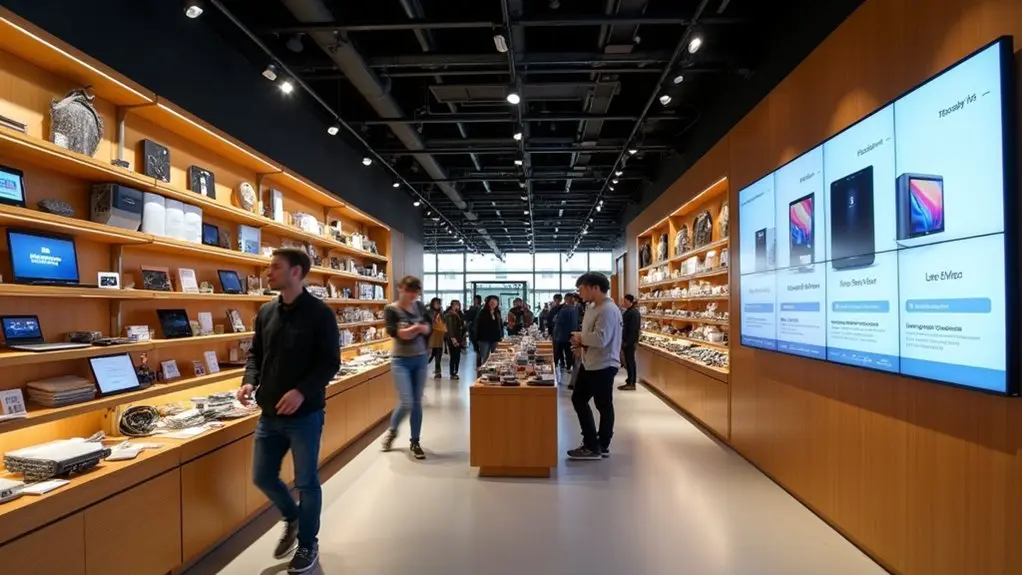To create an Amazon Storefront as an influencer, start by applying through the Amazon Influencer Program with a strong social media presence and audience engagement. Brand the storefront with a custom name, visuals, and regularly updated content to increase trust and conversion rates. Structure recommendations in themed lists, highlight top picks with videos, and analyze metrics to refine your strategy. Authentic, audience-driven content and intuitive organization are key. Explore further to discover advanced branding and growth techniques.
Key Takeaways
- Apply for the Amazon Influencer Program using a strong, engaged social media presence to gain access to your own storefront.
- Customize your storefront with a unique name, branded visuals, and a memorable URL for stronger brand identity and recognition.
- Organize recommended products into clear categories and themed idea lists, making it easy for followers to browse your curated picks.
- Create authentic content, including shoppable videos and personal product stories, to build trust and increase conversion rates.
- Regularly update your storefront and analyze performance metrics to refine your recommendations and maintain an engaging, fresh brand experience.
Understanding the Amazon Influencer Program and Eligibility
How does the Amazon Influencer Program set itself apart in the world of affiliate marketing? Unlike traditional models, it empowers influencers to curate product recommendations on a personalized Amazon storefront, driving higher conversion rates.
Eligibility criteria emphasize an active public account on platforms like YouTube or Instagram, prioritizing audience engagement metrics—such as likes, comments, and shares—over sheer follower count. This guarantees that only influencers with authentic connections and proven engagement are accepted.
Once approved, influencers receive a unique URL and can establish a cohesive brand identity with custom visuals, reinforcing trust and authenticity with their audience. This personalized approach not only enhances brand alignment but also increases earning potential, as followers are more likely to trust—and act on—recommendations from credible, engaged creators.
Setting Up and Customizing Your Amazon Storefront
A significant number of successful influencers recognize that setting up and customizing an Amazon Storefront is a strategic step for maximizing both engagement and conversions.
To begin, influencers must apply through the Amazon Influencer Program, utilizing a strong presence on platforms like Instagram or YouTube. Upon approval, they customize their storefront by choosing a unique name, uploading a brand-aligned profile picture, and adding an eye-catching banner image.
Start by applying to the Amazon Influencer Program, then personalize your storefront with a unique name, profile picture, and banner image.
Creating idea lists helps followers easily navigate curated recommendations. Influencers are advised to regularly update your storefront—at least every 90 days—ensuring content remains relevant and appealing.
Monitoring performance metrics via Amazon Stores Builder allows for data-driven adjustments. Finally, establishing a custom URL not only simplifies sharing but also reinforces brand recognition, amplifying the storefront’s impact within the influencer’s audience.
Organizing and Showcasing Products for Maximum Impact
Effective organization and presentation of products on an Amazon storefront directly influence user navigation and conversion rates. Structuring collections into clear categories and themed groups simplifies the user experience, guiding shoppers to relevant recommendations.
By utilizing storytelling, influencers can showcase products in a way that resonates with their audience, driving deeper engagement. A visually appealing storefront—featuring high-quality images, shoppable videos, and dynamic seasonal displays—entices visitors and reinforces branding recommendations.
Regular updates every 90 days guarantee content remains current and appealing. Data shows that strategic product arrangement and compelling visuals lead to higher click-through and purchase rates.
- Organize products into themed collections for easy browsing
- Use storytelling to connect and showcase products
- Incorporate shoppable videos to boost engagement
- Feature high-quality images for a visually appealing storefront
- Refresh with seasonal displays to maintain audience interest
Creating Authentic Content That Drives Engagement
While many influencers curate visually appealing Amazon storefronts, those who prioritize authentic, audience-centric content consistently see higher engagement and conversion rates.
Data indicates that creating authentic content, particularly through video, directly addresses audience questions and concerns, substantially boosting engagement rates. Authentic storytelling—sharing personal experiences with recommended products—enhances customer trust and forges stronger connections.
Utilizing the Amazon Influencer storefront’s customization options, such as compelling banner images and well-organized product categories, reinforces brand identity while maximizing visual appeal. Regular updates every 90 days keep content fresh, encouraging repeat visits and ongoing relevance.
Additionally, actively seeking audience feedback through polls, Q&A sessions, and livestreams enables influencers to tailor recommendations, further increasing engagement. This method positions influencers as trusted advisors, driving both conversion and loyalty.
Optimizing, Analyzing, and Growing Your Storefront
Building authentic, audience-focused content establishes a strong foundation for engagement, but sustained storefront growth requires ongoing optimization and data analysis.
Influencers must prioritize analyzing performance metrics through the Insights dashboard to refine their storefront design, product selection, and customer engagement strategies.
Prioritize data-driven insights to continually refine your storefront, product selection, and engagement strategies for sustained influencer growth.
By optimizing user navigation with clear categories and idea lists, creators streamline the shopping experience and increase conversions.
Utilizing trends such as shoppable videos and themed collections fosters engaging content and boosts brand management.
Regular updates—ideally every 90 days—ensure relevance and repeat visits.
Balancing high-performing, high-commission products with audience interests is essential for lasting growth.
- Analyze performance metrics to refine strategies
- Optimize storefront design for intuitive user navigation
- Curate engaging content using shoppable videos and collections
- Monitor and adjust product selection based on data
- Implement regular updates for continuous brand management
Frequently Asked Questions
Is Amazon Influencer the Same as Storefront?
The Amazon Influencer Program and storefront are related but not identical; influencer marketing leverages unique storefront features for branding strategies, curated product selection, and audience engagement, differing from traditional affiliate programs through content creation, commission rates, promotional tactics, and niche targeting.
How to Make an Amazon Storefront in the UK?
Storefront setup in the UK requires joining the Influencer marketing program, followed by strategic product curation, strong brand partnerships, optimized affiliate links, tailored content creation, compelling visual aesthetics, data-driven sales strategies, and ongoing performance metrics analysis to engage the target audience.
How Many Followers Do You Need to Make an Amazon Storefront?
The number of followers required is not fixed; instead, Amazon prioritizes social media impact, follower engagement, content strategy, niche market relevance, and audience trust. Strong product curation, effective promotional tactics, and potential for monetization and brand partnerships drive influencer marketing eligibility.
Do You Need 500 Followers for Amazon Affiliate?
The current question addresses follower requirements for Amazon affiliate programs. Influencer marketing success relies more on engagement metrics, niche selection, and quality content creation across social media than a specific follower count, optimizing monetization strategies, Amazon earnings, and potential brand partnerships.
Conclusion
Establishing an Amazon Influencer Storefront empowers creators to monetize their influence while delivering curated, trusted recommendations to their audience. By strategically organizing products, utilizing authentic content, and analyzing performance data, influencers can optimize conversions and build lasting brand authority. With over 300 million active Amazon users, a well-branded storefront not only amplifies reach but also drives measurable results. Consistent optimization and audience-centric strategies are key to maximizing engagement and achieving sustained growth within Amazon’s dynamic marketplace.




